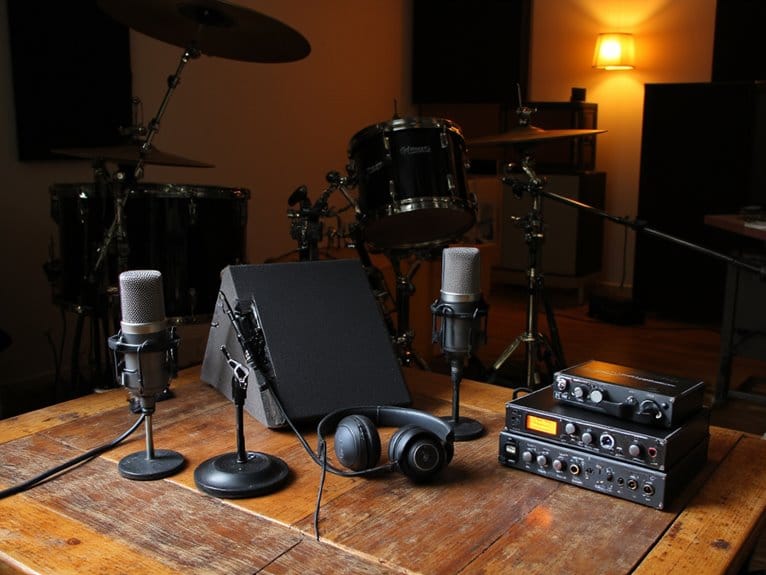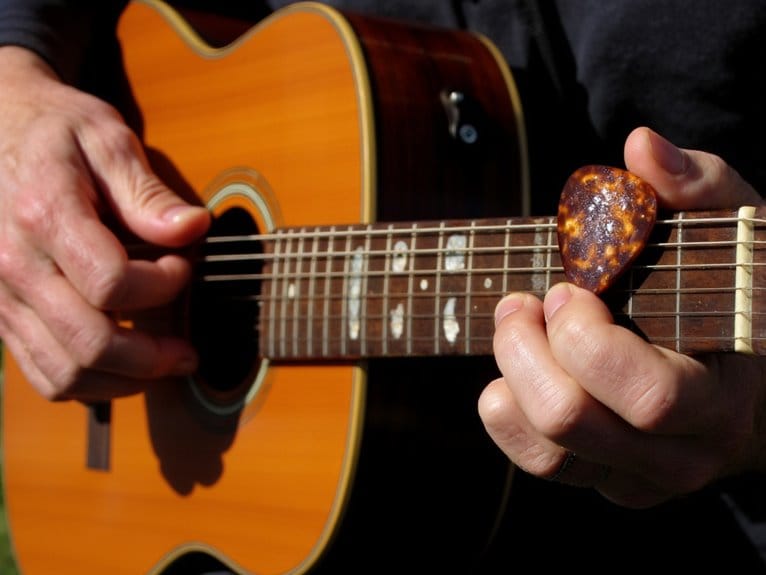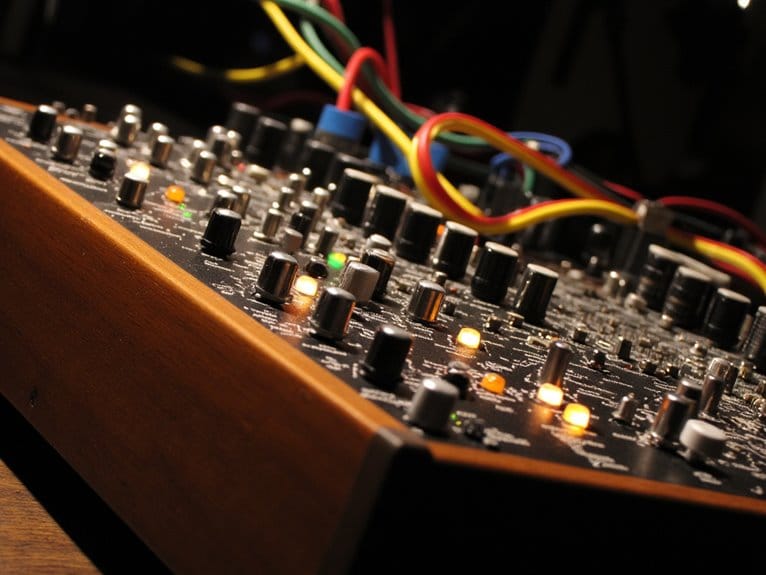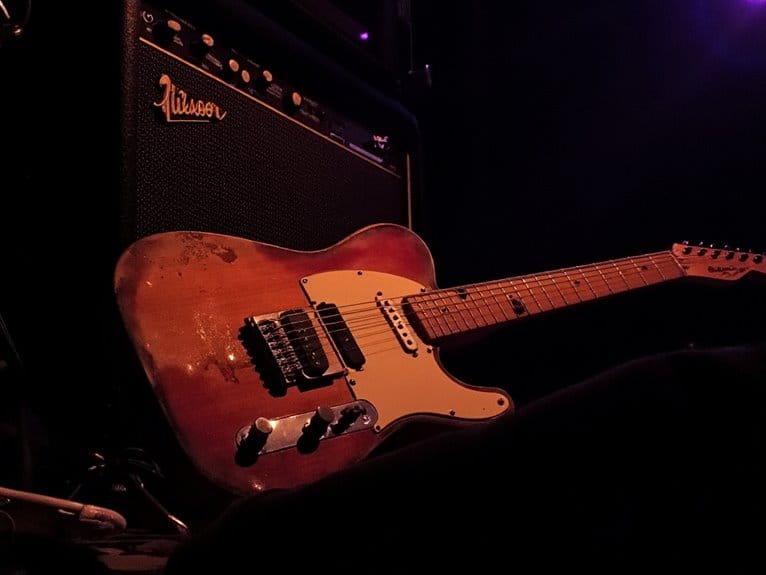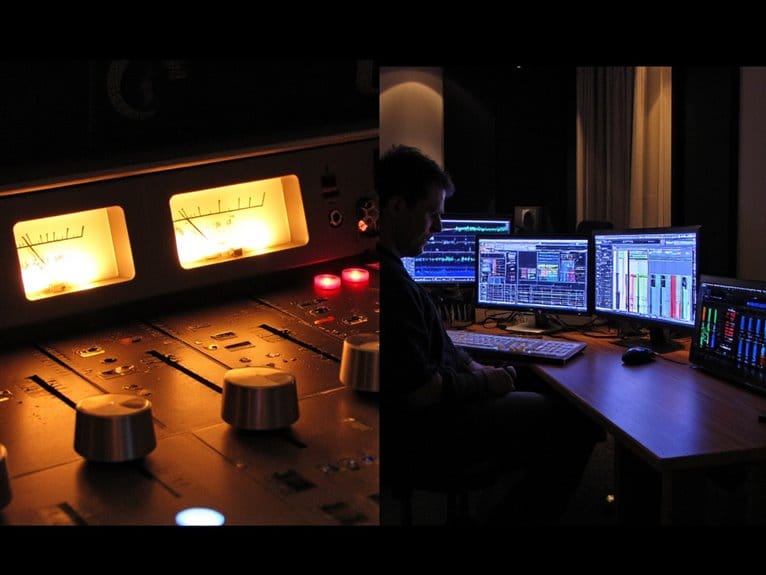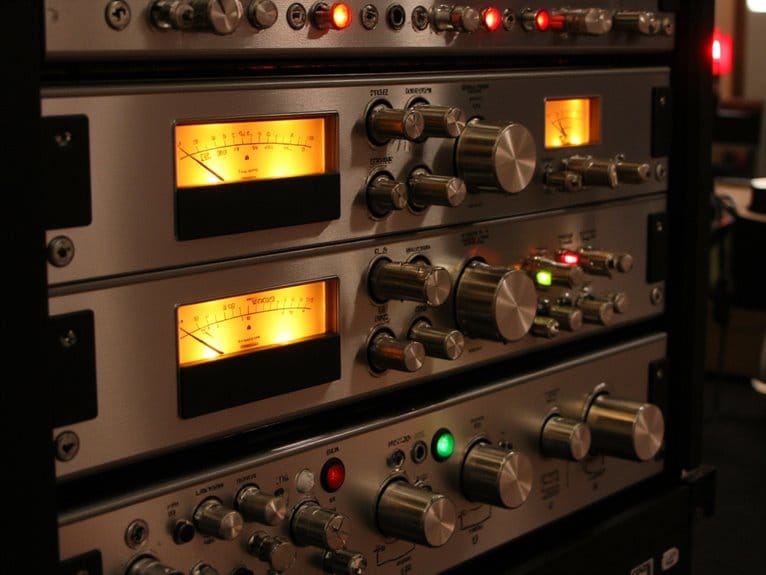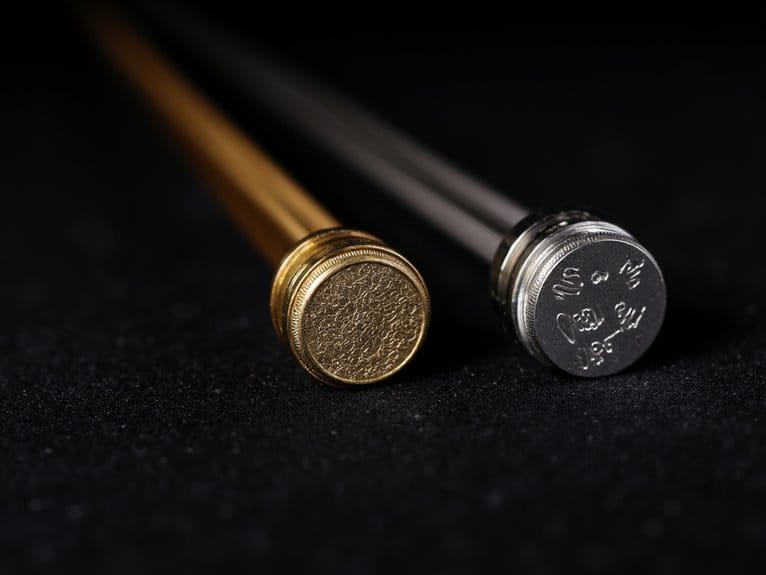Budget-Friendly Drum Recording Gear Guide
You can build a professional drum recording setup for under $500 by starting with versatile microphones like the $120 Shure SM57 for snare duties, pairing it with budget condenser overheads such as the $100 Samson C02 stereo pair. I’ve found that strategic placement techniques, proper drum tuning with quality drum keys, and basic room treatment often matter more than expensive gear when capturing punchy, clear recordings. The upcoming sections reveal specific interface recommendations and placement secrets that’ll maximize your investment.
We are supported by our audience. When you purchase through links on our site, we may earn an affiliate commission, at no extra cost for you. Learn more.
Notable Insights
- The Shure SM57 ($100-$120) serves as an excellent versatile microphone for snare drums and toms in budget setups.
- Choose an audio interface with at least eight inputs like the Focusrite Scarlett 18i20 for complete drum tracking capabilities.
- The Behringer BC1200 mic set offers a complete 7-piece drum recording solution for under $100 with included overheads.
- Strategic microphone placement techniques like close-miking combined with overhead positioning maximize sound quality without expensive gear.
- Prioritize proper drum tuning with drum keys and acoustic treatment over expensive microphones for better overall recording quality.
Essential Microphones for Drum Recording on a Budget
When I started recording drums on a shoestring budget years ago, I quickly learned that choosing the right microphones can make or break your sound without necessarily breaking your bank account. Your drum microphone selection doesn’t require premium gear to achieve professional results, and several low cost alternatives deliver impressive performance.
The Shure SM57, priced around $100-$120, remains my go-to snare mic due to its durability and versatility, while the Shure PGA52 at $114 handles kick drums effectively for budget setups. The SM57’s tailored frequency response emphasizes midrange frequencies that naturally isolate snare sounds from surrounding instruments.
For toms, I’ve found the Sennheiser e604 clip-on mics, at roughly $100 each, provide excellent close-miking capabilities. Dynamic microphones excel in high sound pressure live environments and are known for their durability, making them suitable for touring musicians.
Overhead positioning benefits from small-diaphragm condensers like the Samson C02 stereo pair, which costs approximately $100 and captures cymbals with surprising clarity for home recording applications. The Rode NT5 matched pair delivers minimal EQ adjustments needed for overhead recordings while maintaining budget-friendly pricing. Budget condenser mics with cardioid polar patterns can effectively minimize background noise interference in untreated home recording environments. Complete drum mic sets like the Behringer BC1200 offer 7-piece configurations that include kick, snare, tom, and overhead microphones along with mounting hardware for under $100.
Choosing the Right Audio Interface Without Breaking the Bank
After years of watching recording budgets evaporate on unnecessarily expensive gear, I’ve discovered that selecting the right audio interface represents the most critical decision you’ll make for drum recording, since it serves as the bridge between your carefully chosen microphones and your digital audio workstation.
Interface compatibility becomes paramount when you’re tracking drums, requiring at least eight inputs to accommodate kick, snare, hi-hat, overheads, and room microphones simultaneously. Preamp quality directly impacts your recordings’ clarity and punch, making interfaces like the Focusrite Scarlett 18i20 and Roland Studio Capture worthwhile investments. Poor latency can destroy your tracking experience by creating delays between what you play and what you hear back through your monitors. Additionally, phantom power becomes essential when using condenser microphones for overheads and room mics, as the 48V supply enhances microphone performance and captures more detailed drum recordings. Budget interfaces typically feature USB-C connectivity for reliable connection to both Mac and Windows computers, ensuring broad compatibility across different recording setups. Professional zero-latency monitoring allows real-time audio feedback during drum tracking sessions, eliminating the disorienting delays that can throw off your timing.
- $600-$1000 range: Focusrite Scarlett 18i20, Roland Studio Capture offer ideal input count and preamp quality
- ADAT expandability: Future-proof your setup by adding external preamps when needed
- 24-bit/192kHz resolution: Guarantees professional-quality drum recordings without compromise
- Low-latency drivers: Essential for real-time monitoring during tracking sessions
Strategic Microphone Placement and Setup Techniques
With your audio interface selected and ready to capture every nuance of your drum performance, the real magic happens through strategic microphone placement that transforms a collection of individual drum hits into a cohesive, powerful sonic experience.
Your overhead mics become the foundation, positioned 30″–60″ above the snare depending on whether you want focused clarity or ambient room character.
The Recorderman technique uses two cardioid mics at equal distances from the kick, creating controlled stereo imaging perfect for untreated home studios.
Close mics on individual drums require careful positioning—kick mics inside the drum or where air movement stops, snare mics over the front rim.
For budget-conscious drummers working in apartments or small spaces, electronic drum sets with USB MIDI connectivity can bypass traditional mic placement challenges entirely while still providing professional recording capabilities through direct interface connection.
Room Acoustics and Ambient Microphone Solutions
The difference between amateur and professional drum recordings often comes down to mastering your room’s acoustic character rather than chasing expensive microphones. I’ve learned this lesson through countless frustrating sessions where great performances sounded muddy or lifeless. Your room’s acoustics directly influence how ambient microphones capture the natural reverb and spatial characteristics that make drums sound three-dimensional.
Room acoustics matter more than expensive gear when capturing the spatial depth that separates amateur recordings from professional ones.
Effective acoustic treatments don’t require studio-level budgets:
- Sound absorption sheets with 0.85 NRC ratings reduce reflections by 60%, outperforming cheap foam alternatives
- DIY bass traps using dense rock wool in corners control low-frequency buildup for tighter bass response
- Strategic soundproofing techniques like acoustic sealants and door sweeps prevent sound leaks while improving internal acoustics
- Ambient microphone placement in treated reflective zones captures enhanced room character without unwanted echoes
Cost-Effective Recording Strategies and Essential Accessories
Smart equipment selection and recording techniques matter more than your total budget when you’re building a functional drum recording setup. I’ve watched too many home recordists blow their money on single expensive pieces while neglecting the complete signal chain.
Your microphone choices should prioritize versatility, with the SM57 handling both snare and toms while affordable condensers like the Behringer C-2 pair capture overheads and stereo imaging.
Essential accessories include reliable boom stands, quality cables, and monitoring headphones like the Sennheiser HD 280 Pro for accurate playback. Budget-friendly options like the 5 CORE microphone provide effective background noise rejection, though they may require EQ adjustments to achieve optimal sound.
Recording techniques emphasizing close-miking combined with strategic overhead placement will deliver professional results, while minimal mic count setups reduce complexity without sacrificing quality. Don’t forget that proper tuning with drum keys is essential for achieving the desired sound quality during your recording sessions.
Consider low-volume cymbals during recording sessions to reduce bleed-through and maintain better control over your overall drum mix in home studio environments.
This proves that thoughtful approach trumps expensive gear every time.
Frequently Asked Questions
Can I Record Drums Effectively Using Only My Smartphone or Laptop’s Built-In Microphone?
You can record drums with smartphone recording or laptop microphone, but you’ll face limited frequency response, unwanted noise, and positioning challenges. While possible for demos, built-in mics won’t deliver professional-quality results.
What’s the Minimum Number of Microphones Needed to Get a Professional Drum Sound?
You can achieve professional drum sounds with just two microphones using proper microphone placement techniques like the Glyn Johns method. Focus on overhead positioning and add essential accessories like pop filters for ideal results.
On a final note
You don’t need to mortgage your house for professional drum sounds, and honestly, I’ve heard incredible recordings made with gear that costs less than most people’s monthly coffee budget. Start with the SM57 and a decent interface, learn proper mic placement through experimentation, treat your room acoustically with basic materials, and focus on developing your recording techniques. Your wallet and your recordings will thank you for this methodical, budget-conscious approach to capturing drums.

